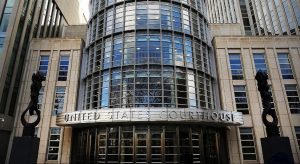
Collateral descriptions in Uniform Commercial Code (“UCC”) financing statements have been the genesis of numerous conflicts between creditors. The purpose of a financing statement is to give notice to subsequent creditors of a prior security interest in personal property . In order to achieve these objectives the financing statement must accurately describe the collateral. However, a subsequent creditor may be required to do more than simply review active UCC-1 financing statements to determine whether a given debtor has already encumbered its personal property assets, and ambiguities may only serve to impose additional duties of inquiry on the subsequent creditor.
This was the subject of a dispute recently decided in the United States Bankruptcy Court for the Western District of Missouri in In re: 8760 Service Group, LLC (In re 8760 Service Group, LLC, 65 Bankr. Ct. Dec. (CRR) 170, (Bankr. W.D. Mo. 2018)).
In In re: 8760 Service Group, LLC, the debtor, 8760 Service Group, LLC (“Debtor”), operated a custom industrial construction and fabrication business with its office located at 1803 W. Main Street, Sedalia, Missouri. (“Main Street Property”). The creditor, Bancorpsouth Bank (“BCS”) , made a number of loans to Debtor and Pelham Property, LLC (“Pelham”), a single purpose entity formed to own the real property located at 5105 Pelham Drive, Sedalia, Missouri (“Pelham Property”), from which Debtor operated its fabrication facility. Debtor was the only member of Pelham. To secure these loans, Pelham executed and recorded a deed of trust and fixture filing on the Pelham Property in favor of BCS, and Debtor granted BCS a personal property security interest in collateral described in BCS’s UCC-1 financing statement as “all accounts receivable, inventory, equipment, and all business assets located at [the Main Street Property]”. Subsequently, a blast booth was installed in the building located at the Pelham Property. It was funded by proceeds from Pelham’s construction loan from BCS. However, the construction contract and the invoices for the blast booth’s construction were in the name of Debtor.
Subsequently, Hudson Insurance Company (“Hudson”) provided payment and performance bonds for the account of the Debtor. To secure Debtor’s repayment obligations to Hudson in connection with the bonds, Debtor granted security interests to Hudson in substantially all of Debtor’s property. Hudson filed a UCC-1 financing statement with respect to Debtor’s inventory, equipment and accounts.
The Debtor and Pelham subsequently filed Bankruptcy, and a dispute arose between BCS and Hudson as to the existence and priority of their respective and competing security interests in the inventory and equipment of the Debtor, including the blast booth located on the Pelham Property.
BCS contended that the collateral description in its UCC-1 financing statement filed against the Debtor could reasonably be interpreted two ways: (1) that the address restricts all described collateral to only that which is located on the Main Street Property, OR (2) that the commas separating out the various types of collateral, and addition of the second “all” (i.e., “and all business assets located at…”(emphasis added)) serve to limit the effect of the reference to a specific property address only to the business assets of the Debtor, and that BCS’s security interests in “…all accounts receivable, inventory, equipment…” mean precisely that; all accounts receivable, inventory, equipment, wherever they may be located, including equipment (i.e., the blast booth) located on the Pelham Property. BCS went further in asserting that since there were two reasonable interpretations then its financing statements were not seriously misleading and triggered a duty to further investigate the extent of BCS’s security interest. The Court agreed with BCS. The Court reiterated that it views the validity of a financing statement in terms of whether “it provides notice that a person may have a security interest in the collateral claimed.” Further, the Court noted that the UCC recognizes further inquiry may be necessary and that therefore, errors or omissions in the description of the collateral do not render financing statements ineffective unless they are seriously misleading. Based upon that reasoning, the Court held that Hudson’s claim in the Debtor’s equipment (including the blast booth) was subordinate to BCS’s.
This case should serve to remind creditors that if the collateral description in a pre-existing UCC-1 financing statement is ambiguous or subject to multiple interpretations, it is incumbent upon the subsequent creditor to reach out to the existing creditor(s) to clarify and/or confirm the nature and extent of any pre-existing liens on the collateral.

By Christopher Gravell
Associate at Frandzel Robins Bloom & Csato, L.C.

By Brian L. Bloom and Gerrick Warrington
The law is often complex and convoluted. But in some cases, the law is remarkably simple and straightforward. In Black Sky Capital, LLC v. Cobb, decided on May 6, 2019, the California Supreme Court opted for simplicity and followed a straightforward interpretation of California’s anti-deficiency statute, California Code of Civil Procedure section 580d, to provide relief to a creditor who, holding two deeds of trust secured by the same property, foreclosed on the senior deed of trust and, in a separate action, sought to recover a money judgment as to the amount still due and owing on the junior deed of trust, which was extinguished due to the creditor’s foreclosure. The Supreme Court’s intervention resolved a deep conflict amongst the California Courts of Appeal.
Facts and Background
In August 2005, Citizens Business Bank (the “Bank”) extended a loan to Michael and Kathleen Cobb (the “Cobbs”) in the amount of $10,299,250.00 (the “Senior Loan”), which was evidenced by a promissory note and a deed of trust (the “Senior Deed of Trust”) secured by commercial property located in Rancho Cucamonga, California (the “Property”). More than two years later, in September 2007, the Bank extended a second loan to the Cobbs in the amount of $1,500,000.00 (the “Junior Loan”), which was evidenced by a promissory note and a deed of trust (the “Junior Deed of Trust”) secured by the Property. Subsequently, the Bank sold both notes and assigned the Senior Deed of Trust and the Junior Deed of Trust to Black Sky Capital, LLC (“Black Sky”) in January 2014.
The Cobbs defaulted on the Senior Loan, and on June 10, 2014, Black Sky sent a notice of default and election to sell the Property under the Senior Deed of Trust (the “Senior NOD”). After failing to cure the defaults that gave rise to the Senior NOD, Black Sky foreclosed the Senior Deed of Trust and acquired the Property at a trustee’s sale for the sum of $7,500,000.00 on October 28, 2014. As a result of the foreclosure of the Senior Deed of Trust, the Junior Deed of Trust was extinguished.
One week after completing the foreclosure of the Senior Deed of Trust, Black Sky brought suit against the Cobbs in San Bernardino County Superior Court to collect the amounts due and owing under the Junior Note. In resolving the case, the trial court’s focus was on California Code of Civil Procedure section 580d(a) (“Section 580d”), which states, in relevant part, as follows:
“[N]o deficiency shall be owed or collected, and no deficiency judgment shall be rendered for a deficiency on a note secured by a deed of trust or mortgage on real property or an estate for years therein executed in any case in which the real property or estate for years therein has been sold by the mortgagee or trustee under power of sale contained in the mortgage or deed of trust.”
The trial court ruled in favor of the Cobbs, holding, based on prior Court of Appeal precedent from 1992, that Section 580d precludes a deficiency judgment for a junior lienholder who was also the foreclosing senior lienholder. Specifically, the trial court relied upon the so-called “Simon rule,” which originated from the Court of Appeal case Simon v. Superior Court (1992) 4 Cal.App.4th 63, which found that this situation—creditor forecloses on senior deed of trust, but still holds junior note—comes within California law’s prohibition against collecting a “deficiency judgment” against the borrower. California’s anti-deficiency statutes provide, among other things, that a creditor holding a note secured by a deed of trust or mortgage on real property may not collect a “deficiency judgment” (i.e., the difference between the amount owed to that creditor less the fair market value of the real property) if the real property is sold at foreclosure for less than the full amount of the debt.
On appeal by Black Sky, the Court of Appeal reversed the trial court’s decision. Reviewing Supreme Court precedent in this area from 1963, the appellate court concluded that Section 580d does not preclude a deficiency judgment for a nonselling junior lienholder who also holds the senior lien. As noted by the Court of Appeal, the Supreme Court had ruled, in Roseleaf Corp. v. Chierighino (1963) 59 Cal.2d 35, that where a creditor foreclosed a senior deed of trust by a borrower, Section 580d did not prevent a different creditor from seeking a money judgment against the same borrower. The Court of Appeal did not find a reason, under the circumstances presented in the Cobbs’ matter, to distinguish between junior liens held by the same creditor and a different creditor under the Roseleaf Corp. decision. By doing so, the Court of Appeal declined to follow the Simon rule and three other Court of Appeal decisions that adopted the Simon rule.
Supreme Court Ruling
In order to resolve a conflict amongst the Courts of Appeal on the issue, the Supreme Court agreed to weigh in and heard oral arguments in February 2019. Three months later, the Court unanimously concluded that Black Sky was not barred from pursuing a money judgment against the Cobbs as to the Junior Loan. In analyzing the text of Section 580d, the Supreme Court stated that the plain language of the statute compelled the result: “The plain language of the statute bars a deficiency judgment ‘when the trustee has sold the property ‘under power of sale contained in the…deed of trust.’” (Slip Op. at 9; emphasis in original). The definite article (i.e., the word “the”) in the phrase “the…deed of trust” makes clear that the statute is referring to the deed of trust under which the power of sale has been exercised, and not another deed of trust. Thus, Section 580d did not bar Black Sky from seeking to collect against the Cobbs with respect to the debt due and owing on the Junior Loan: “Because no sale occurred under the deed of trust securing the junior note in this case, section 580d does not bar a deficiency judgment on the junior note.” (Slip Op. at 12). The holding in Black Sky thus represents a significant change in California law as to the scope of Section 580d.
The Supreme Court’s decision also makes practical sense. Were Section 580d to be interpreted as barring deficiency judgments under these circumstances, lenders would be disinclined to extend additional credit to borrowers secured by the same property. Borrowers would then be forced to turn to other creditors, but the extension of credit on a second position lien by a different creditor normally costs borrowers more due to the additional risks being assumed by the junior lender.
The Court’s analysis did come with an important caveat: “Where there is evidence of gamesmanship by the holder of the senior and junior liens on the same property, a substantial question would arise whether the two liens held by the same creditor should – in substance, if not form – be treated as a single lien within the meaning of section 580d.” (Slip Op. at 10-11). For example, Section 580d may be applicable in a scenario where a creditor extended multiple loans days apart and secured by the same property, were the loans a part of the same transaction. However, that was not the case before the Court, as the two loans held by Black Sky were made more than two years apart involving separate transactions.
The Supreme Court’s decision in Black Sky Capital, LLC, v. Cobb puts to rest an issue that has vexed trial courts and the California Courts of Appeal for years, as its simple and straightforward decision provides benefits to both lenders and borrowers.
Feel free to contact us at (323) 852-1000 if you have any questions concerning these types of issues.

By Brian L. Bloom
Associate at Frandzel Robins Bloom & Csato, L.C.

By Gerrick Warrington
Associate at Frandzel Robins Bloom & Csato, L.C.

In Bankruptcy, Are Both the Prevailing Party and the Oversecured Creditor Entitle to Attorneys’ Fees When the Oversecured Creditor Loses the Action on a Contract?
In a case that should grab every commercial lenders’ attention, a bankruptcy court in the Central District of California in Altadena Lincoln Crossing LLC, 2018 Westlaw 3244502 (Bankr. C.D. Cal. 2018) disallowed an over $10 million default interest component to the bank’s proofs of claim, finding that the default interest was an unenforceable penalty under California’s liquidated damages statute, California Civil Code section 1671(b), which provides that “a provision in a contract liquidating the damages for the breach of the contract is valid unless the party seeking to invalidate the provision establishes that the provision was unreasonable under the circumstances existing at the time the contract was made.” The Court found that there was no evidence demonstrating that the parties negotiated or even discussed the issue of default interest before or at the time the contracts were made. As a result, the Court disallowed the entire $10 million default interest component as being categorically unenforceable under California law.
The gravity of the Altadena default interest analysis has been discussed by numerous commentators, including Loyola Law School’s Professor Dan Schechter.
But, this article analyzes a different issue raised by the Altadena case: whether an oversecured creditor is entitled to attorneys’ fees and costs when it loses a claim objection and the debtor is declared the prevailing party on the contract under state law. In Altadena, the bankruptcy court appears to have disallowed the bank’s attorneys’ fees and costs related to its defense of the debtor’s claim objections, finding that the debtor was the prevailing party on the contract because it prevailed on its claim objections. But, the categorical disallowance of the bank’s attorneys’ fees based on a state law fee-shifting statute is not an obvious result, given that the bank was an oversecured creditor. As analyzed below, courts have taken different approaches to this situation.
Background
In Altadena, the debtor, Altadena (“Debtor”), filed claim objections to two proofs of claim filed by East West Bank (“Bank”), an oversecured creditor. The Bank’s first claim included a default interest component of over $10 million and the second claim included a default interest component of over $175,000. The court found that there was no evidence that the parties’ agreed-upon 5% default interest provision was the product of the parties’ pre-contractual efforts to estimate a fair average compensation for the foreseeable loss that the Bank might suffer in the event of default. As a result, the court disallowed these default interest components, finding them to be unenforceable penalties under California Civil Code section 1671(b).
The court also found that the Debtor was the “prevailing party” on the claim objections, finding that because the Debtor was the “prevailing party” on the claim objections, the Bank should exclude its fees and costs incurred in connection with the claim objection litigation. Altadena, 2018 WL 3244502 at *12 (“[The Bank] shall file and serve one or more declarations setting forth its calculation of the attorneys’ fees and costs that it is entitled to recover as part of its secured claims, which declarations shall include as attachments copies of time records reflecting the relevant services. As the Debtor is the prevailing party with regard to the Objections, these calculations should not include fees or costs incurred in connection with litigation of the Objections. . . .”).
Thoughts
Altadena is interesting because under state law, the bank would not be entitled to attorneys’ fees since it was not the “prevailing party on the contract,” but under bankruptcy law, it was entitled to recover its “reasonable” attorneys’ fees as an oversecured creditor under section 506(b) of the Bankruptcy Code.
Although not expressly analyzed in the opinion, the court’s “prevailing party” reference may have been a reference to California Civil Code section 1717(a), which provides a reciprocal right to attorneys’ fees to the “prevailing party on the contract.” But, generally, oversecured creditors are entitled to “reasonable fees, costs, or charges” under section 506(b) of the Bankruptcy Code.
Other courts confronted with this situation have found that the oversecured creditor is entitled to attorneys’ fees and costs, subject to a federal reasonableness analysis, which is not limited by state law “prevailing party” or fee-shifting analysis. See In re Hoopai, 581 F.3d 1090 (9th Cir. 2009) (analyzing pre-2005 BAPCPA version of section 506(b) and finding that an oversecured creditor was entitled to post-petition / pre-confirmation attorneys’ fees which could not be limited by state law despite the fact that the debtor was the prevailing party under Hawaii fee-shifting statute); In re McGaw Property Management, Inc., 133 B.R. 227 (Bankr. C.D. Cal. 1991) (awarding oversecured creditor attorneys’ fees under section 506(b), but also awarding debtor attorneys’ fees under California Civil Code section 1717(a) as the debtor was the prevailing on the contract, i.e., the claim objection at issue).
A federal “reasonableness analysis” looks very different than the all-or-nothing “prevailing party” analysis under state law. See In re Le Marquis Associates, 81 B.R. 576, 578 (9th Cir. BAP 1987) (“Reasonableness embodies a range of human conduct. The key determinant is whether the creditor incurred expenses and fees that fall within the scope of the fees provision in the agreement, and took the kinds of actions that similarly situated creditors might reasonably conclude should be taken, or whether such actions and fees were so clearly outside the range as to be deemed unreasonable. The bankruptcy court should inquire whether, considering all relevant factors including duplication, the creditor reasonably believed that the services employed were necessary to protect his interests in the debtor’s property.”) (citations omitted).
It is not clear whether these issues were raised at the bankruptcy court level in the Altadena case, and from the decision itself, it appears that this argument was not raised. But, unless all of the Bank’s attorneys’ fees incurred in defense of the Debtors’ claim objections were beyond the pale, the Bank’s section 506(b) entitlement means the Bank may have been entitled to recovery of at least some of its fees insofar as those fees were determined to be reasonable under federal law.
Commercial lenders concerned about the enforceability of default interest and attorneys’ fees and costs should contact attorneys at Frandzel Robins Bloom & Csato, L.C. to discuss these complex issues, which are important at the formation the lending relationship through bankruptcy and beyond.

By Gerrick Warrington
Associate at Frandzel Robins Bloom & Csato, L.C.

Recent Federal Case Reaffirms California Law Holding that Absent Extraordinary and Specific Facts, a Bank Does Not Owe a Duty of Care to Non-Customers
California law has long held that a bank does not owe a duty of care to non-customers in the absence of allegations of extraordinary and specific facts. So, for example, in Software Design & Application v. Hoefer & Arnett (1996) 49 Cal.App.4th 472, a group of investors sued two banks for negligence, alleging that the banks failed to supervise and monitor withdrawals and transfers from accounts which the defendant financial consultant and his sister were using to misappropriate the plaintiffs’ investments. The Court of Appeal upheld the dismissal of the negligence claims based on the rule that “absent extraordinary and specific facts, a bank does not owe a duty of care to a noncustomer.” (Id. at 479.) The Court found that the investors were neither customers nor past customers of the banks, and had not alleged any special facts, such as an investor being the alter ego of the account holder or an intended beneficiary of the account, which could have given rise to a duty of care. (Id. at 480-481.)
In the recent case of Evans v. ZB, N.A. (E.D. Cal. Dec. 20, 2017) 2017 U.S. Dist. LEXIS 209632 (“Evans”), the United States District Court for the Eastern District of California reaffirmed this rule. The Evans case was a class action against a bank on behalf of over fifty people who had invested in a corporation which was allegedly operating a Ponzi scheme and misappropriating funds. The corporation maintained its accounts at the bank. After the corporation filed bankruptcy, the investors, none of whom were bank customers, sued the bank for, among other things, negligence and aiding and abetting fraud. They argued that the bank owed them a duty to protect them from the corporation’s fraud.
In granting the bank’s motion to dismiss the case, the District Court reaffirmed California’s rule of no liability to non-customers in the absence of specific facts: “The primary flaw with regard to [the plaintiff investors’] argument, which plaintiffs rely on for all of their claims, is that plaintiffs were neither … customers nor had any relationship with [the bank], and a bank does not owe a duty of care to noncustomers unless extraordinary and specific facts are present. … Because plaintiffs have alleged no such facts, [the bank] was under no legal duty to warn plaintiffs about [the corporation’s] financial condition …” (Evans at *2-3.)
It should be noted that the Court in Evans also recognized an important exception to the rule: that tort liability may be imposed upon a bank in favor of a non-customer in a situation where sufficient facts are alleged showing that the bank had actual knowledge that the account-holder was using its account for the purpose of misappropriating funds. (Evans at *3-4.) The Evans Court did not apply the exception, however, because no such facts were alleged: “The only relevant question therefore becomes whether [the bank] had actual knowledge that [the corporation] was operating a Ponzi scheme and misappropriating funds. … Here, plaintiffs have not pled sufficient facts to give rise to a plausible inference that defendant knew [the corporation] was misappropriating funds. … To support their claim that [the bank] was aware of [the] Ponzi scheme, plaintiffs point to an October 2009 letter in which [the bank] informed [the corporation] that it intended to ‘disengage from the Lending relationship’ because ‘there has been little to no revolving of the outstanding balances.’ … However, even if this demonstrates that [the bank] was aware that [the corporation] could not meet its financial obligations, it does not sufficiently allege that the bank knew that [the corporation] was engaging in fraud and misappropriating money. Accordingly, plaintiffs’ Complaint fails to plead more than ‘alleged knowledge,’ and instead ‘essentially alleges the [bank] knew something fishy was going on with the accounts opened by’ [the corporation] … which is insufficient to plead a cause of action for any of the eight claims plaintiffs assert …” (Id., citations omitted.)

On September 30, 2018, California Governor Jerry Brown signed into law Senate Bill 1235 (SB 1235). SB 1235, which overwhelmingly passed the State Legislature and Senate on August 31, 2018, mandates that certain “providers” of “commercial financing” provide a list of disclosures to a class of “recipients”. Subject to exceptions, a “provider” is any person who provides commercial financing to a recipient. “Commercial financing” encompasses a broad array of extensions of commercial credit, such as (a) loans in a principal amount of $5,000.00 or more for which the proceeds are primarily used for commercial purposes, (b) accounts receivable transactions (including factoring), and (c) asset based lending. A “recipient” is defined as a person who is presented with a specific commercial financing offer by a provider that does not exceed $500,000.00.
The new law will not come into effect until after the California Department of Business Oversight has adopted final regulations to implement it. Given that the next California election is in November 2018, it is unlikely that any regulations will be implemented until after the next Commissioner of the Department of Business Oversight is sworn into office, so the earliest possible effective date would be January 7, 2019.
Subject to exceptions and other provisions, the law will require the following disclosures by providers of commercial financing to recipients, which the recipients will need to acknowledge in writing:
- The total amount of funds provided;
- The total dollar cost of the financing;
- The term or estimated term;
- The method, frequency and amount of payments;
- A description of prepayment policies; and
- The total cost of the financing expressed as an annualized rate.
The law will sunset on January 1, 2024. However, except for the provisions regarding the total cost of the financing expressed as an annualized rate, the remainder of the law will automatically become operative again on January 1, 2024.
The new law does not apply to (i) a provider that is a depository institution, such as a traditional bank, (ii) a provider that is a lender regulated under the federal Farm Credit Act, (iii) a commercial financing transaction secured by real property, (iv) certain dealers covered under the California Vehicle Code, and (v) any person who makes no more than one commercial financing transaction in California in a 12-month period, or any person who makes five or fewer commercial financing transactions in as 12-month period that are incidental to the business of the person relying upon the exemption.
While SB 1235 will not be effective until the regulations are implemented by the Department of Business Oversight, once the regulations are issued, it will be imperative for any providers of commercial financing to recipients to comply with the statute and the regulations once they go into effect.

It is well known that LIBOR is going away in 2021. Much has been said and written about this fact, and the reasons for its demise, since the issue was raised in 2014. However, with the deadline looming a couple of years away, exactly what progress has been made?
The SOFR (Secured Overnight Financing Rate) is the replacement rate that has been pushed to the forefront by the Alternative Reference Rates Committee (“ARRC”) appointed by the New York Federal Reserve. This rate was first published on April 3, 2018, by the New York Federal Reserve Bank and is now published each business day at approximately 8:00 a.m. The new rate is based on an average of short term repo loans that are backed by Treasury securities.
The transition to the SOFR in the traditional lending space will require market acceptance and adaptation. In what has been hailed the first big step in the direction of such acceptance in late July, Fannie Mae sold $6,000,000,000 of adjustable rate securities with interest at the SOFR plus a small spread. While meriting a story in the Wall Street Journal, it should be noted that this particular transaction does not provide any guidance to lenders who recognize the need to “do something” with respect to existing loans already on the books that mature after the critical date in 2021.
In anticipation of LIBOR being eliminated in 2021, a transition timeline has been published; however, the primary focus now is on products other than term lending. Many lenders may take comfort in the fact that their loan documents provide that in the event the LIBOR Rate is unavailable, the lender may substitute an alternative index, which is usually some variation of Prime Rate. A couple of problems come to mind in connection with relying on this provision.
One concern is that the current alternate rate provisions in existing loan documents were intended to address a potential short disruption (whether mechanical or otherwise) in the ability of a financial institution to obtain a LIBOR quote in the market; these provisions were never intended to be a long-term fix for any and all issues that arose. Another issue is that the SOFR is an overnight rate that does not deal with either credit risk concerns and/or stress in the credit markets. Consider that if this fall back rate was implemented today, prime rate plus any spread is going to be significantly higher than the current LIBOR, which could even be more of any issue as prime rates continue to rise. The long and the short of it is that the SOFR it is not going to be readily adopted in its current form as it does not reflect long term risk.
On a positive note, the Alternate Reference Rates Committee has implemented working groups to address business loans, variable rate notes and mortgages, and is in the process of developing a rate that can be used in the syndicated loan market. It is anticipated that the SOFR will be modified to include a one or three month rate option (as opposed to an overnight rate) and that some quantum of risk will be incorporated.
On a not so positive note, it has also been suggested that LIBOR will not completely go away in 2021, opening the door for a “Zombie rate”. The Zombie rate could take a couple of forms. One possibility that has been suggested is that a lender and a borrower could agree that on the day the last the LIBOR is published in 2021, that published rate would govern the loan going forward to its maturity date. The other way that zombies could walk the earth is that a handful of banks will continue to quote a LIBOR rate of some sort. Neither one of these scary things should come to pass, but accelerating the LIBOR replacement process will cause bankers to sleep better.








